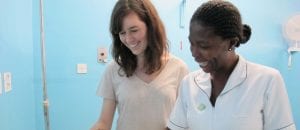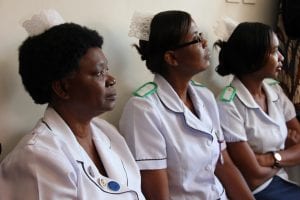Good afternoon and happy Tuesday!
We’ve been trying to feature this guest blogger for a quite awhile, but she’s been in Malawi since February! For the last three months, she’s been in Blantyre running clinical trials on Rice 360°’s AutoSyp device, a syringe pump designed to automatically deliver medicinal doses for up to 66 hours without wall electricity.
Meet, Erica Skerrett ’15, one of our incredible Global Health Fellows and AutoSyp Project Leader.
Erica writes:
I’ve been in Malawi since February. Together with Christina, a recent electrical engineering graduate from the Polytechnic, I’ve been working on getting the AutoSyp validation up and running at Queen Elizabeth Central Hospital (QECH).
Our goal for the study is to understand how access to a low-powered and simple-to-use syringe pump will benefit maternity wards, particularly in the administration of magnesium sulfate (MgSO4) to women who suffer from severe pre-eclampsia and eclampsia.
LAYING THE GROUNDWORK
Christina and I attended the VentureWell Workshop in Blantyre, where we focused on exploring business plans and market strategies for the device. We also visited each of the 3 district hospitals where we plan to expand our study after this summer. There, we presented the study to District Health Officers and maternity staff.
This initial work helped clarify how the needs and operations of district sites differ from the referral hospital in Blantyre.
NURSE TRAININGS & EMPLOYMENT
Christina and I have been working with the head study nurse at QECH to conduct nurse trainings on how to accurately and thoroughly monitor patients. In the initial phase of our study, we’ll be collecting baseline data from the monitoring forms to understand treatment protocols, outcomes, and patient reports of pain.
All maternity nurses have the opportunity to sign up for rotating shifts whenever they’re off regular duty. Those who sign up will help audit and track these monitoring forms and serve as extra hands in the extremely understaffed ward.
This method of nurse employment is very different from common QECH practices. It’s also different from the type of employment we opted for in our bCPAP study.
By employing all the nurses in the ward, we hope they’ll become accustomed to carefully monitoring MgSO4 treatment and feel comfortable using AutoSyp instead of seeing it only as a device for “study nurses”.
STUDY CHALLENGES
This employment system is great for long-term use of the pump and gives us more insight into how it will be used in the ward after the study; however, it comes with a few more challenges than if we employed a single study nurse.
There is a breadth of responsibility when it comes to proper form collection. Training is a more extended and tedious process.
Christina and I have been shadowing in the ward everyday so that we can quickly catch problems as they arise. As a long term solution, we’ve employed a head nurse to help us with nurse scheduling and monitoring.
FURTHER PROGRESS
In addition to all of the above, so much has been happening in parallel to the study. We’ve been:
- conducting usability studies to determine how we can make the syringe pump setup and programming more intuitive for our end-users and
- collaborating with Third Stone Design on the beta prototypes.
This week, we’re meeting with an engineer at Physical Asset Management (PAM) to learn about how syringe pumps are used in QECH’s different wards, how they are commonly broken or misused, and PAM’s role in maintenance and repair.
During this trip, I’ve seen my role transition from being one that is technically-driven to one more focused on building the partnerships necessary to lay the groundwork for product implementation.
I’m heading back to the U.S. next week, but I’ll be in constant contact with Christina and the entire QECH study team until I return to Malawi with the beta devices later this summer!
Thanks for reading!
Erica

